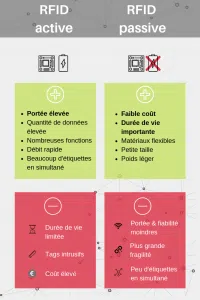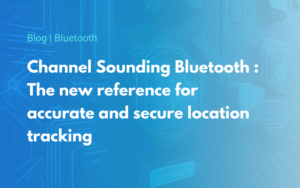
Radio Frequency Identification (RFID) is frequently used on a daily basis, without us even realizing it, in various and varied fields of activity. It makes it possible to convey data, to memorize them and to retrieve them remotely thanks to radio waves. RFID is often used for product identification and the automatic collection of information on items, without any physical connection, unlike other technologies such as gencode for example. It can be declined mainly in two different ways. It is then a question of active RFID or passive RFID.
Basic principle of RFID
The basic systems of RFID are made up of several components. Among them, the tag, also called “radio tag“, composed of an electronic chip for identification and data storage, an antenna, used for communication, and a reader or interrogator for the transmission and reception of waves. A computer and software are also required for data storage and analysis. Depending on the type of radio tag used, no battery or battery is required (passive tags), a battery may be needed only for the emission of the wave (semi-passive tags) or to power the tag and for the emission of the wave (active tags).
RFID TAG
The RFID tag is a fundamental support of electronic identification. It is often composed of two main elements: an antenna, receiving the waves, and an electronic circuit, in charge of processing and storing the information. In other words, it houses an identifier and data on a chip, itself connected to the antenna. The tag thus exchanges data with a reader via radio waves. Widely used in RFID, the tag is very useful to meet traceability requirements, for example, since it does not necessarily need to be seen to be detected and, therefore, read.
READER
The reader is an electronic device used for transmitting and receiving electromagnetic waves. It detects and recognizes the tag’s identification information through the identifier provided by the chip manufacturer. It is also able to decode the information carried by the incident wave thanks to a decoder.
RFID ANTENNA
The RFID antenna can capture and emit electromagnetic waves. The frequency of emission depends on the type of antenna, its length and the frequency set in the chip. Depending on the desired application, the antenna should be inexpensive, non-invasive and as environmentally friendly as possible. In order to maximize energy transmission, the impedance of the antenna must be equivalent to the impedance of the electronic chip contained in the tag. In most cases, this impedance has a value of 50 omega.
COMPUTER
The computer and software are used to store the information collected by the reader. In some situations, they may also control the player.

Basic RFID Operation
Active RFID
First of all, it can be a question of active RFID. In this first case, the tags are powered by an embedded energy source. It can be a battery or a cell, for example, allowing the operation of the tag and the emission of its data.
Active RFID is used in a number of sectors, including construction, public works, security and home automation. Active tags are largely used for monitoring physical quantities (temperature, humidity, movement). This is particularly the case for monitoring the cold chain in refrigerated lorries. They can also be used to identify and track people for safety purposes on building sites. Finally, they can also be used for access control or automatic identification of goods. Translated with DeepL.com (free version)
Pros
- Major advantage: long range.
- Ability to store much more information than passive tags.
- Tags with a host of additional functions.
- Fast transmission rate.
- Large number of labels that can be read simultaneously.
Cons
- Tags are expensive and have a limited lifespan.
- These tags are relatively intrusive because they are medium-sized and therefore visible.
The range
Active tags have a very long range of up to 500 m. Other technologies, which we will refer to later in this blog, extend this distance to the kilometer.
Passive RFID
In a second case, it is passive RFID. Unlike active tags, passive tags do not contain an on-board power source. Instead, they rely on the wave emitted by the reader to power their chip, modulate the signal and, by backscattering, transmit the signal to the reader.
Pros
- Low cost.
- Save time.
- The use of flexible materials. Tags can sometimes be made of paper or fabric, making them less polluting for the environment (provided, of course, that the metallic ink used for the antenna is also environmentally friendly).
- These include their small size, light weight and long service life.
Cons
- Few labels can be read simultaneously in this system.
- Their range and reliability are still much less than those offered by active tags, and they are more fragile.
The range
The passive tags have a range spread over 3 levels.
- Low Frequency is about short distance, when the contact is only a few centimetres away.
- The medium distance is between a few centimeters and 1 meter. This is High Frequency. NFC, for example, has a reading distance of 10 cm in the general case.
- Finally, the maximum distance extends to 15m and uses Ultra High Frequency
Further information
Some studies even evoke a third type of RFID: the semi-passive one. Less known of the general public and consequently less used, this device borrows characteristics of the active RFID (the presence of a battery on the tag, to feed it only this time) and properties of the passive RFID (concerning the system of emission). The lifespan of these tags is higher than an active tag and their cost is less important. They remain however more expensive than passive ones.

RFID vs Bluetooth Low Energy
RFID and Bluetooth Low Energy (BLE) are two wireless technologies used to track and manage objects, but they differ in the way they work. RFID, whether active or passive, is commonly used in logistics and access control, with tags requiring specific readers and antennas. Passive tags depend on energy from the reader, while active tags have their own power supply. BLE, on the other hand, is a low-power version of Bluetooth, easy to deploy with a lighter infrastructure and compatible with existing smartphones and networks.
BLE stands out for its greater range, which can be used outdoors, and its low energy consumption, which is ideal for IoT devices and tracking solutions. In comparison, RFID is more limited in terms of distance, especially in its passive form. BLE therefore offers a flexible solution that is simple to implement and interoperable with other wireless technologies, making it a modern alternative to RFID in some cases. To find out more, read our article comparing the two communication protocols in more detail.


